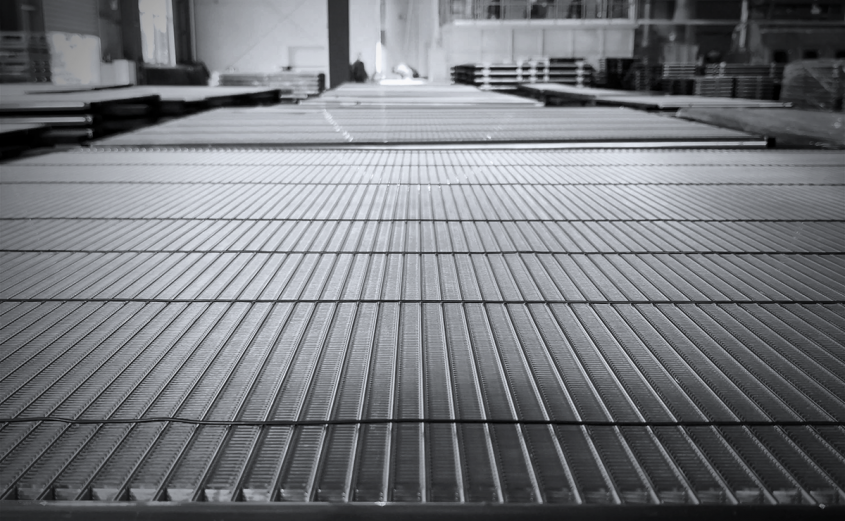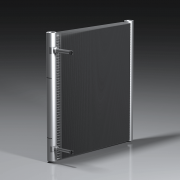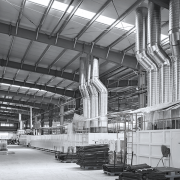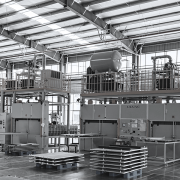Microchannel coils in single-phase heat transfer applications
Single-phase heat exchangers are widely used today for a variety of cooling and heating applications and in different types of equipment. These include free cooling systems, dry coolers, air conditioners, and more, where the most common media is water or glycol mixtures. Microchannel coils in practice became the norm in condenser applications, and, more recently, microchannel heat exchangers became an alternative to finned tube coils that used traditionally for water applications.
With microchannel coils, a number of advantages become available to the customers, including:
- Higher heat transfer performance: an inherent property of microchannel heat exchangers
- Reduced water/glycol volume due to a smaller internal volume of the coil
- Weight reduction
- Lower air pressure drops and the resultant reduction in fan power
- Higher corrosion resistance, especially with long-life alloys used in manufacturing
- Robust construction
- Lower cost
At the same time, the following aspects should be assessed during the design of equipment and systems based on air-water microchannel heat exchangers:
- Water quality: as the ports of flat microchannel tubes feature small, (sometime submillimeter) sizes, water must not contain considerable particles and impurities, or an appropriate filter must be used
- Using a corrosion inhibitor in the cases when pipework contains dissimilar metals
- High water velocities may lead to erosion of aluminum microchannel tubes
- Thermal expansion of the coil body shall be taken into account
Direct replacement of finned tube heat exchanger to microchannel coil is possible in many situations, but to achieve maximum effect, some essential changes in the system design need to be taken.
Thermal Performance
Microchannel tubes can be made with ports of various geometries, and their size and shape could have a significant impact on the thermal and hydraulic performance of a heat exchanger. Our theoretical research and following field tests demonstrated that circular ports (as well as ports with a high degree of roundness) give the best thermal and hydraulic performance among other port shapes. The number of ports per tube and hydraulic diameter of the port influence both thermal performance and tube-side fluid resistance: increasing the number of ports with the decreasing of their size leads to an increase in both heat transfer and pressure drop. It must be noted, that using the ports with excessively small diameters might lead to the need for high-quality fluid filtration by installing mesh strainers with small sieve sizes, and, as a consequence, to excessive system pressure drops.
Even fluid distribution among the microchannel tubes is essential for adequate performance of a heat exchanger. Equal feeding of the flat tubes in single-phase microchannel coils is achieved by maintaining low pressure in the inlet manifold of special design. Vertically-oriented manifolds will give better flow distribution than horizontal. However, the vertical headers are not practical for evaporator applications because of poor condensate evacuation from the fins.
In contrast to traditional finned tube coils and due to its design, microchannel heat exchanger enables using a wide assortment of fin types, and the best choice – from the performance point of view – is louvered fins with the carefully selected pitch, louver angle, and length: wrong fin sizing may lead to excessively high air pressure drops and lower coil performance.
The surface roughness of tube channels is yet another factor affecting the thermal performance of a microchannel heat exchanger: on the one hand, high roughness lead to an earlier transition to turbulent flow and higher heat transfer performance, on the other, to increased pressure drops, and this drawback overcomes the enhancement in the heat transfer coefficient. Given this, high-quality tubes with smooth channel surfaces are preferable for use in microchannel heat exchangers.
When properly designed, microchannel heat exchanger offers significantly higher thermal performance, which, in turn, often resulting in a reduction of components used in the system design, and a lower final cost of the equipment.
Airside Efficiency
Not surprisingly, microchannel heat exchangers have significant advantages in airside performance: shorter air passage – compared to finned tube coil of the same capacity – and absence of obstacles for the air flow such as round tubes lead to lower airside pressure drop, resulting in reduced fan power consumption and may allow using smaller and cheaper fans. The customers may also benefit from reduced noise output coming from lower fan rotation speeds.
From the studies of air pressure drop evolution during the fouling process of microchannel coils, we experienced that fin pitches below FPI=24 (for louvered fins) were significantly more prone to fouling, and this effect shall be considered at the equipment design phase.
Corrosion Resistance
The absence of dissimilar metals in the construction of microchannel coils reduces the risks of galvanic corrosion to a minimum.
Chemically induced corrosion may be a result of complex chemical interaction between the materials used in the heat exchanger design and the fluid circulated through it. We always recommend adding corrosion inhibitors in order to prevent damaging caused by tube-side chemical reactions.
Other possible sources of the corrosion are chemically polluted air and/or salted marine atmosphere. E-coating is a proven and reliable method to prevent corrosion caused by aggressive air pollutants and salts. With e-coating, the heat exchanger is immersed in a bath with a water-based solution containing a paint emulsion. An electric current is then applied to the heat exchanger core to attract the particles that are suspended in the liquid and deposit them onto the surface of the coil. The electrodeposition continues until the desired level of coating thickness is achieved. The coated coil is then cured in an oven to promote cross-linking. It must be taken into account that a coating layer causes an increase in airside pressure drop (5 to 10 percent).
With e-coating in combination with advanced alloys developed especially for brazed aluminum heat exchangers (including 9000 series alloys), we experienced a huge improvement in corrosion resistance, observed in the SWAAT tests.
Installation
The microchannel coil itself is a robust frame and does not need additional supporting elements. In order to avoid the contacts between coil body and adjacent metal parts and prevent galvanic corrosion, as well as to provide the space for thermal expansion of the coil, we recommend mounting the heat exchangers with rubber or plastic sealings. This shall also ensure an airtight seal between the coil and interfacing components.
Equipment design consideration must be made for thermal expansion. Because aluminum has a high coefficient of thermal expansion, the equipment frame and mounting method of the coil must accommodate thermal expansion of the coil in both height and width dimensions. The linear coefficient of expansion for aluminum (about 24ppm/°C) is 35% higher compared to copper (about 18ppm/°C). Thus, the minimum allowance for thermal expansion must be one millimeter per meter of the coil height/width assuming 80°C temperature differential. If high ambient or low ambient operation is expected, thermal expansion allowance should be increased based on the superheat temperature at the high-pressure safety cutout, minus the lowest expected ambient operating temperature.
Heat exchanger shall be connected to the external pipework so that the connections shall not be exposed to thermally induced stress or tension.
Another aspect that should be considered during the equipment design phase is header orientation, and, consequently, the orientation of flat tubes. For example, evaporator coils shall demonstrate adequate condensate drainage behavior and a coil with vertical flat tubes should thus be selected to ensure free water shedding. The coils with horizontally-oriented tubes are not acceptable from this point of view.
Inclination angle also affects heat exchanger performance, air- and tube-side resistances, and, again, condensate behavior. For laminar flow, the heat transfer coefficient for dry conditions is not affected significantly by the inclination angle of a heat exchanger, but it may be substantially deteriorated as the inclination angle to horizontal increases in case of fully developed turbulent flow. For the wet surface, heat transfer degrades with the increased inclination angle and as Reynolds number increases.
With the variation of coil installation angle, the airside pressure drop increases systematically with face velocity and inclination angle, for both dry and wet conditions. For wet conditions, the pressure drop is about 5 to 10 percent larger compared to one for dry conditions at the same face velocity.
The impact of gravity on the water or glycol solution flowing through the microchannel heat exchanger is relatively small, with the maximum difference between the results of horizontal and vertical tubes less than 5%.
Microchannel heat exchangers can be successfully used in HVAC systems in water and glycol systems – as cooling, free cooling coils, heating coils, and more. The benefits are obvious, but due attention should be paid to the specifics of heat transfer and fluid flow in microchannels. Any coil should be selected not only depending on environmental conditions and required performance but should possess the characteristics necessary for a specific application.
Kaltra customers could benefit from the experience and assistance of our engineers and from our best practices to obtain the desired results and choose the most suitable heat exchangers for their application.








